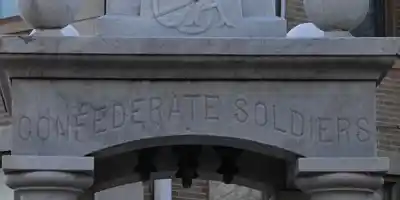By Berry Craig/For The Sentinel
Murray State University historian Brian Clardy said that Confederate monuments are the most visible symbol of the Lost Cause myth, which holds that slaves were universally happy in bondage and that slavery had little or nothing to do with the Civil War. Myth-makers and preservers, he added, also claim the Confederacy was based on “states’ rights” and that the North forced the South to fight to defend those “rights.”
Clardy said that by “states’ rights” the Confederates meant the right of states to sanction slavery. (White Southerners also cried “states’ rights” in defense of Jim Crow segregation and Black disenfranchisement.)
Retired Morehead State University historian John Hennen said that after Reconstruction — when the Jim Crow era started — “there was a conscious effort by white Southerners to deny that the Civil War had anything to do with slavery. Oh, no, they said they fought in defense of local sovereignty.” He said “states’ rights” in the antebellum South meant preserving slavery and white supremacy. (In the 1960s, Congress passed landmark civil rights legislation aimed at ending Jim Crow racism.)
In his 2001 book, Apostles of Disunion: Southern Secession Commissioners and the Causes of the Civil War, historian Charles B. Dew wrote that after the Confederates lost the Civil War, many of their civilian and military leaders wrote memoirs, in which they maintained “that slavery had absolutely nothing to do with the South’s drive for independence.” He added that their whitewash is being applied by “neo-Confederate writers and partisans of the present day.”
In his book, Dew quoted the Confederates themselves on what prompted secession and the creation of the Confederacy.
Jefferson Davis praised slavery as a worthy institution by which “a superior race” had transformed “brutal savages into docile, intelligent and civilized agricultural laborers.”
Vice President Alexander H. Stephens was thankful the Confederacy was based “upon the great truth that the negro is not equal to the white man; that slavery, subordination to the superior race, is his natural and moral condition.” He added that the Confederate States of America was, therefore, “the first Government ever instituted upon principles in strict conformity to nature and the ordination of Providence…”
Dew also quotes from secession ordinances Southern states wrote as they exited the Union. When Texans pulled out, they denounced “the debasing doctrine of the equality of all men, irrespective of race and color — a doctrine at war with nature, in opposition to the experience of mankind, and in violation of the plainest revelations of Divine Law.”
Mississippi secessionists announced that “Our position is thoroughly identified with the institution of slavery…. We must either submit to degradation and to the loss of property worth four billions of money, or we must secede from the Union.”
Dew focused his book on a group of state-appointed commissioners who made the rounds of the slave states in 1860 and early 1861. They preached the same racist line: the only way to keep Lincoln and the Yankee “Black Republicans” from destroying slavery and white supremacy was to start a new Southern nation.
“Our fathers made this a government for the white man, rejecting the negro, as an ignorant, inferior, barbarian race, incapable of self-government, and not, therefore, entitled to be associated with the white man upon terms of civil, political, or social equality,” a Mississippi commissioner said.
Declared another Magnolia State representative: “Slavery was ordained by God and sanctioned by humanity.”
Likewise, a Kentucky-born Alabama commissioner to the Bluegrass State pleaded that secession was the only way the South could sustain “the heaven-ordained superiority of the white over the black race.” Another Alabama ambassador said ideas that slavery was immoral and that God created all people the same were rooted in “an infidel theory [that] has corrupted the Northern heart.”
Dew concluded, “By illuminating so clearly the racial content of the secession persuasion, the commissioners would seem to have laid to rest, once and for all, any notion that slavery had nothing to do with the coming of the Civil War.”
Kentucky’s Confederate press: slavery and white supremacy were on the line
Kentucky’s pro-Confederate newspapers stuck to a theme common to the Confederate press throughout the South: only secession could save slavery and white supremacy.
Typical of the Confederate papers was the Louisville Daily Courier, the state’s most important secessionist organ. For example, the Courier pandered directly to less well-heeled Kentuckians who did not have slaves: “Have the non-slave holders of Kentucky ever thought of the…effect of the emancipation of all the slaves in the country? Do they wish to send their children to schools in which the negro children of the vicinity are taught?”
The questions continued, rapid-fire: “Do they wish to give the negro the right to appear in the witness box to testify against them? Do they wish to see the negro privileged to serve on juries sitting on their property, liberty, or life? Do they wish to be met at the polls, and have their votes neutralized, by the suffrage of the free negroes? Do they wish to have the emancipated slaves brought into competition with them in the field, in the workshop, in all the pursuits of life?”
The smaller Confederate papers pushed the same racist line. The weekly Princeton Bulletin challenged its readers to “reflect on how you would like [emancipated slaves]…to become as they would by this step, the every day companions and associates of your wives and children; your peers at the ballot box, and your legislators in public assemblies.”
The weekly Cadiz Organ demanded to know if white Kentuckians would at Lincoln’s “command…bow their heads and receive again the yoke of free negro Black Republican despotism and inequality”? Or would they “stand as idlers and behold an army of Abolition minions, with hearts festering with treason as black as hell itself, attempt to force our friends, our neighbors, our brothers of the South, into ignominious SUBMISSION TO NORTHERN RULE AND TYRANNY?”
The Confederate constitution and slavery
Meeting in Montgomery, Ala., the first Confederate capital, in February 1861, representatives of the original seven Confederate states drew up a constitution that explicitly safeguarded slavery.
They modeled their charter after the U.S. constitution but “purged the original of euphemisms, using the term slaves instead of other persons in its three-fifths and fugitive-slave clauses. It bound the Congress and territorial governments to recognize and protect ‘the institution of negro slavery,’” Columbia University historian Stephanie McCurry wrote in The Atlantic.
“But the centerpiece of the Confederate constitution—the words that upend any attempt to cast it simply as a copy of the original—was a wholly new clause that prohibited the government from ever changing the law of slavery: ‘No … law denying or impairing the right of property in negro slaves shall be passed.’ It also moved to limit democracy by explicitly confining the right to vote to white men. Confederates wrote themselves a pro-slavery constitution for a pro-slavery state.”
(Some Confederate apologists like to point out that the constitution’s framers outlawed the transatlantic slave trade. But their motives were political, not humanitarian. The Confederates were desperate for British recognition and support. Resurrecting the slave trade, which the U.S. constitution banned after 1808, would have risked a confrontation with Britain’s powerful navy, the ban’s chief enforcer.)
Clardy said that for years after the war, “Lost Cause” proponents deliberately ignored historical evidence and depicted the defeated Confederates as helpless victims of vengeful, victorious Yankees.
But the ex-Confederates got off astonishingly easy compared to losers in other armed rebellions in other countries. There were no mass executions, no mass imprisonments and no mass confiscation of land and property. Most former rebels ultimately got their citizenship back; after Reconstruction, the pre-war planter aristocracy — including many who had been leaders in the Confederate military and government — returned to dominance in Southern politics and society. They called themselves “Redeemers.”
The Ku Klux Klan, the Redeemers’ terrorist arm, used violence to help subvert biracial, freely-elected Republican-led Reconstruction governments, to intimidate the newly-freed slaves and Republicans, and to reinstate white supremacy and oppression of Blacks as close to slavery as possible under the 13th Amendment to the Constitution which outlawed slavery.
Armed, hooded, and robed Klansmen and members of similar secret groups lynched, tortured, and burned-out Blacks, while local law officers looked the other way. More than a few lawmen were Klansmen. Nonetheless, the United Daughters of the Confederacy (UDC) spread the Lost Cause lie, insisting that Klansmen and their ilk were heroes and gallant defenders of white Southern homes and hearths — and especially white Southern womanhood.
In a Facing South article, Greg Huffman wrote that in 1926, the UDC even erected a monument to the Klan. Its inscription read in part: “IN COMMEMORATION OF THE ‘KU KLUX KLAN’ DURING THE RECONSTRUCTION PERIOD FOLLOWING THE ‘WAR BETWEEN THE STATES’ THIS MARKER IS PLACED ON THEIR ASSEMBLY GROUND.”
“Let’s just call Confederate soldiers what they were–traitors,” said Clardy. “They were disloyal to the United States. They shed American blood, and they do not need to be lionized for that.”
Berry Craig is a professor emeritus of history at West Kentucky Community and Technical College in Paducah. He lives in Arlington, Kentucky, and is the author of seven books on Kentucky history, including three published by the University Press of Kentucky: Kentucky Confederates: Secession, Civil War, and the Jackson Purchase (2014), Kentucky’s Rebel Press: Pro-Confederate Media and the Secession Crisis (2018) and Kentuckians and Pearl Harbor: Stories from the Day of Infamy (2020). He co-authored two other books and has written articles for The Register of the Kentucky Historical Society and The Jackson Purchase Historical Society Journal.




